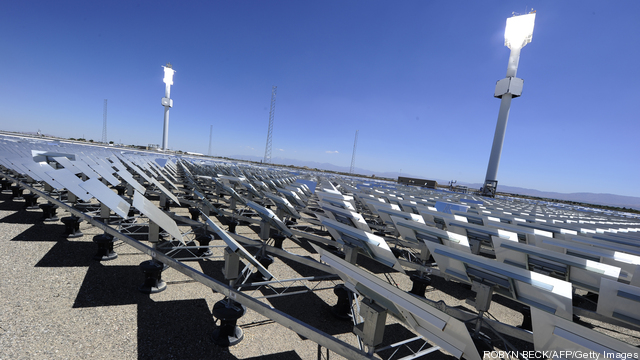
Last September, Breaking Energy named five cleantech IPO‘s that were set to break the charts and change the game for renewable energy on the stock market. One of those five was Brightsource.
But despite the hype that had some industry insiders calling the BrightSource IPO the possible start to a cleantech gold rush, the thermal solar company cancelled its initial public offering last week due to what the company said were “adverse market conditions.”
“While we received significant interest from potential investors, the continued market and economic volatility are not optimal conditions for an IPO,” said John Woolard, President and CEO of BrightSource Energy, in a company statement.
“We made this decision from a position of stregnth,” Keely Wachs, senior director of corporate communications for BrightSource told Breaking Energy. “We have a strong financial position, support from world-class investors and partners, one of the largest solar pipelines in the US and a disruptive technology.”
She explained that in the ten days leading up to the scheduled IPO date, various specific events occurred that led BrightSource executives to believe the IPO was not well-timed:
- The Volatility Index (VIX) increased by 33%
- DJIA and S&P both fell 2.4%
- Nasdaq Cleanedge Index fell 6.6%
- Solar stocks fell dramatically; FSLR fell another 14.5%
- High growth / cleantech composite fell 8.9%
- Another solar company, Enphase, priced 46% below range
- Solar Trust’s Chapter 11 bankruptcy announcement on April 4th
In filing for the IPO with the Securities and Exchange Commission (SEC) last April, BrightSource executives capped available stock at $250 million, with a proposed maximum offering price of $23 per share. See the filing here. But as it cancelled its IPO, BrightSource will have to make do with its private sector investments and government loan guarantees.
BrightSource is one of a growing number of concentrated solar power (CSP) solar company that use thermal energy, rather than photovoltaic technology to turn sunlight into electricity. A typical CSP operation has a water-filled power tower surrounded by heliostat mirrors that reflect and aim the sunlight towards the water which is then heated, converted into steam, and used to spin an electric generation turbine.
Unlike solar PV, CSP can produce massive quantities of electricity: BrightSource’s largest development, the 750 MW Rio Mesa Solar Eletric Generating Facility, is currently awaiting official approval from the California Energy Comission to be built in the state’s Riverside Country.
And, unlike photovolatics, CSP plants can also store electricity using molten salt to slowly release the heat overnight or during cloudy days. BrightSource has developed its own SolarPLUS thermal energy storage technology which its plants to add to several of its CSP plants.
Since its founding in 2004, BrightSource – headquartered in Oakland, California – has secured 14 power purchase agreements (PPAs) to deliver approximately 2.6 GW of installed capacity to PG&E and and Southern California Edison. The company is currently operating or developing a total of five CSP facilities in Israel and California, including a 6-MW research, development and testing facility, the Solar Energy Development Center (SEDC), located in Israel’s Negev desert.
In April 2011, the company’s 392 Ivanpah plant was partially financed with a $1.6 billion Department of Energy loan guarantee, NRG Solar invested a further $300 million in the project and another $168 million came from Google.
So with all of its successes, BrightSource’s eleventh-hour exit from its planned IPO on April 11 came as a sudden shock to the industry, which – after the Solyndra collapse last summer – could have benefited from a much-needed second wind. Preparing a company for a public stock offering is not an easy task, meaning a successful IPO could have been a clear and sure sign of strength for a sector that is rapidly consolidating as solar power nears grid parity.
But choosing to forego the IPO might have also been the surest sign of BrightSource’s stregnth. When Solyndra fell many claimed it had tried to grow too quickly too soon. The patience to expand the company slowly but surely might be a positive industry development. And BrightSource claims it only has more growth in its future.
“We will continue to execute on our business plan to grow domestically and expand internationally to meet the growing demand for our technology,” Woolard said in announcing the IPO withdrawal last week.
